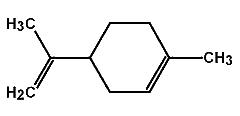Introduction
Citrus fruit oil is a product obtained from Citrus fruit on both Lemon and Grape fruit, with strong solvent properties. It contains valuable and essential composition that is helpful to human body when applied on the skin. It affects the skin by energizing it.
Chinese companies make many products which include essential recipes oil as well as medicines products. These products are used as a phytonutrient and anticarcinogenic with various components including Linalool and Limonene as a major bi- product (Turner, Harris 1952, 6 – 12).
Limonene
This is a family of hydrocarbon found naturally in Citrus fruit and it has an odorless component smell of Oranges. It is found in a group of Alkenes with a functional formula group of C=C and can be distilled without decomposition hence it is widely practiced as a carvone product which is extracted from the peel through filtration process by CO2 as a reagent (Pakdela, Panteaa and Roy2001, 21 – 32).
Structure and properties of limonene
It is made up of two bi-products. The first limonene product is l-limonene component which has turpentine perfume smell. The second bi- products is d- limonene component which has a pleasurable orange smell. These two products of limonene component have molecular formula of C10H16 with molecular structure as shown below (Simonsen 194, 7 41 – 53).

Isolation of Limonene
D-limonene compound is used as insecticides and contains about 88% of citrus oil which is used as a solvent and flavor in beverages. D-limonene product can be found naturally or manufactured synthetically by using an extractor. During this preparation, the oil is separated from the juice and after condensation process, it is left floating on the surface of water. A certain fragrance compounds and orange oil are obtained by juicing process (Blumann, Zeitschel 1914, 62 – 68).
Steam distillation process is applied on cyclic orange peel terpene. During this preparation, d-limonene which is a bi-product of limonene is produced in a solution of water. At a room temperature, the product is observed as odorless spirit. This water solution is placed in a test tube and since the limonene is much denser than water, it is sucked while floats on the water. D-limonene is a compound of citrus oil prepared in a special way with a compound formula of R-1-methyl-4 cyclohexene and a molar mass of about 136.0 g/mol at a stable compound (Matura, Goossens, Bordalo 2002, 70 – 77).
Characteristics
Limonene has a formula of C10H16 and exists naturally with various properties. It rotates when placed in two polarized plates. A spectrophotometer instrument is used to record results of the preparation of limonene. This record is suitable when making visible boundary layers of substances. In addition, it can also be used as resin products, hand washing pastes and as a spray component insecticide (Mann, Hobbs, Banthorpe, Harborne 1994, 83 – 87).
Conclusion
All in all, a Limonene component is a product of Citrus oil which is available naturally with a smell of lemon orange. It is prepared synthetically using an extractor. It has various characteristic that has positive or negative results. It is very important since can be used as a detergent and also as a spray as well as a medicine. It is commonly used on skin protection and also as a perfume with a pleasant smell.
Reference List
Blumann & Zeitschel (1914). Berichte 47: 2623.
Turner. E, Harris.M (1952). Organic Chemistry. London: Longmans, Green & Co.
Pakdela. H, Panteaa. D, Roy.C (2001). Production of dl-limonene by vacuum pyrolysis of used tires. New York: Oxford press.
Simonsen. J (1947). The Terpenes 2nd ed.). London:Cambridge University Press.
Matura. M, Goossens. A, Bordalo. O (2002). Oxidized citrus oil (R-limonene): a frequent skin sensitizer in Europe. J. Am. Acad. Dermatol. 47.
Mann, J. Hobbs, J. Banthorpe and D. Harborne, (1994). Natural products: their chemistry and biological significance. England: Longman Scientific & Technical.